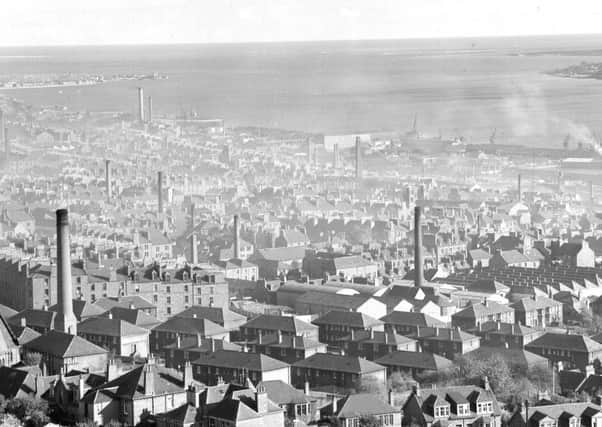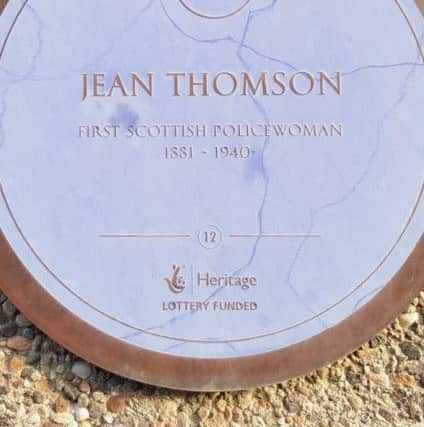OTD 1918: Scotland's first paid policewoman hits the streets


Here, Sarah Aitken, assistant archivist at Dundee City Archives looks back at the historic appointment.
Dundee was a bit different when it came to 19th century gender politics.
Advertisement
Hide AdThe predominance of factories in the city, in particular those making jute, meant that there was a high demand for a female workforce.


The city was even known as “women’s town” or “she town”. Should it then come as a surprise that 100 years ago the City Police employed the first paid, uniformed policewoman in Scotland?
Women were not new to law enforcement. Many were employed as turnkeys in prisons and Dundee had women in such roles.
But by the 1910s many saw the growing need for women in the police force as part of the effort to solve social problems. By this time women were already working with the police in Germany and the US. They were generally employed to help with female prisoners and victims, as well as crimes involving children. But what really kick started things in this country was the war.
War in 1914 led to many policemen signing up to do their duty at the Front. This led to a shortage of Bobbies on the beat.
In reaction to this groups of women set up local patrol groups. In Dundee the Women’s Patrol Committee was started in January 1915. Groups of women would patrol Dudhope Park, Magdalen Green and the Greenmarket. A suggestion to the Dundee Chief Constable in March 1915 that women fulfil temporary constable positions (needed because of the amount of men that had joined up) was quickly rebuffed.
Advertisement
Hide AdMeanwhile, in September 1915, Glasgow decided to employ a women in their police force. Emily Miller was the first policewoman in Scotland, although she later described herself as more of a “lady assistant” than a police officer.
In March 1918 the temporary constable suggestion was brought up again in Dundee but dismissed as women had no power of arrest. The following month a petition from the National Union of Women Workers (who ran the Patrol Committee) asked the Chief Constable to prepare a report into the prospect of employing women police officers. They wanted the Police to employ two police women, and to give the voluntary patrols a uniform of hats (with a hat badge) armbands and white gloves.
Advertisement
Hide AdThe main stumbling block appears to have been the legal issue. The Scottish Office encouraged female patrols but gave no approval for the appointment of female constables. The Chief Constable argued that the need for female police in Dundee was limited as they had no powers of arrest. He did however agree to employ a Police Sister to act as a link between the police and the voluntary patrols. On 16th May 1918 Mrs Jean Thomson was appointed and the patrols were given hat badges of the city coat of arms and armbands. As Mrs Thomson would have worn this uniform too, she then became the first female uniformed police officer in Scotland.
Who was Mrs Thomson? Born Jean Forsyth Wright on 17th August 1881 in Lochee. Her father was minister at the Parish Church and Jean lived at the Manse until her marriage in 1902 to William Thomson, a Chemist at the Royal Infirmary. The couple moved to Primrose Cottage at 19 Union Street, Lochee and had three daughters: Christina Meikle (b. 1903), Margaret Forsyth (b. 1904) and Jean Wright (b. 1908).
In 1911, Jean is recorded in the census as being the manager of the Nursing Mother Restaurant Lochee. This was set up as a one stop shop were new mothers could get access to milk, advice and health check-ups for their babies. The first restaurant was set up by Mary Lily Walker, noted Dundee social activist.
We don’t know how long Jean worked there but we assume that at some point during WW1 she started volunteering with the Police Patrols. At this time she and her three daughters lived with her mother and brother William at 142 City Road.
But as far as the Chief Constable was concerned Mrs Thomson was not a police officer. In 1922 he is said to have denied that any women were employed as police constables. To some extent he was right. Mrs Thomson wouldn’t have had the power of arrest and was paid a lot less than her male colleagues. Her duties involved patrolling, interviewing female suspects and escorting women prisoners. Two years later Chief Constable Carmichael explained to the People’s Journal that there was no need for women patrols in Dundee as all of the town’s women were all “in the factories during the day.”
Mrs Thomson remained employed by the police until her resignation on 11th August 1922.
Advertisement
Hide AdShe served in the police for over four years. But why did she leave? During a meeting of magistrates on May 6 1922, the question of whether the Police Sister was necessary was posed.
At this time the Police Service was under significant constraints and looking to decrease their budget. The vacancy was not filled and in November a general freeze was put on all police recruitment in Dundee. It also seems there were growing frustrations about her lack of status and pay. Was it a resignation based on principle or did she just need a better paid job? In 1927 a vote was held by the Magistrate’s Committee on whether to employ women.
Advertisement
Hide AdAfter hearing the Chief Constable speak on the matter (sadly what he said is not recorded) there was a unanimous vote not to employ women.
It wasn’t until the passing of the Police (Women) (Scotland) Regulations in 1934 that Dundee appointed another police woman. The Scottish Office authorised the appointment of one woman in the city but Dundee asked for two women on practical grounds. On 29th January 1935 Annie Ross was appointed as Dundee’s first Woman Police Constable (WPC). 70 women applied for the job.
But what happened to Jean Thomson? We’re not sure what she did after resigning from the police – allegedly she worked as a secretary for a Major in the Territorial Army for a couple of years. We know she still lived with her mother, but they moved to 14 Adelaide Place. Her mother died in 1935 but Jean is listed as the occupant of the house in the valuation records until 1942. The next time we find her is in 1954 when she witnesses her brother’s death. By this time she had moved to Norfolk. She died in Wells-next-the-sea on 8th September 1964 at the age of 83. Her daughters also lived long lives: Christina died in 1995 and Jean died in 1990, both lived with their mother in Wells. Margaret, who married Thomas Brown Stewart in 1936, lived in Slough and died in 1992. The three daughters are beside each other in Market Lane cemetery, Wells.
